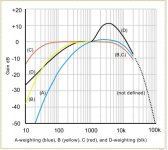Mount the shakers to something that will act as a diaphragm, like a false wall or ceiling.The downside is that I could only perform my composition for one person at a time. Also, my area of focus is in the sort of ambient infrasound, the kind that is subtly experienced. I feel that the obvious shaking that occurs from tactile transducers is going to misrepresent infrasound.
what is your budget? I built one of these http://www.diyaudio.com/forums/subwoofers/143714-lab12-tapped-horn.html for an interactive new media bull poop installation when I was in college. It will reasonably hit 16 hz and lower if you are careful. however its quite impractical afterwards, too low for a pa sub, great for a theater. its BIG. Building it wasn't too bad but if you've never used a table saw before it might be a tad ambitious. you might be better off with a dual 18 and careful management with a max msp patch since most speaker management dsp wont go below 20hz.
Hi,
if you want to go low, you need to go big. I have an idea for a dual LAB-12 big box horn that might suffice, and depending on your wood costs could be <800$. But it's a 3000l monster - floor to ceiling height, over 1m^2 cross section, and probably about 10 (!) sheets of plywood to build. But it would do 120db from 10Hz and up if properly corner loaded.
I doubt you can get much more than that at your budget using traditional drivers - low frequencies eat cone excursion for breakfast, and unless you can control it with proper horn loading, you'll run out soon. And horn loading at this frequency requires vast truck-length horns - think 20 thousand liters or more. Probably not in the money/time budget to build
if you want to go low, you need to go big. I have an idea for a dual LAB-12 big box horn that might suffice, and depending on your wood costs could be <800$. But it's a 3000l monster - floor to ceiling height, over 1m^2 cross section, and probably about 10 (!) sheets of plywood to build. But it would do 120db from 10Hz and up if properly corner loaded.
I doubt you can get much more than that at your budget using traditional drivers - low frequencies eat cone excursion for breakfast, and unless you can control it with proper horn loading, you'll run out soon. And horn loading at this frequency requires vast truck-length horns - think 20 thousand liters or more. Probably not in the money/time budget to build
In order to play with this idea musically, I first need to be able to produce infrasonic tones.
The cheapest way to produce LOUD infrasound is to place a sealed speaker enclosure inside a chamber of rather low volume. Say, use a 12-15" woofer in a sealed box, placed inside a small pickup truck cab.
If your university has a large technical department, maybe you could use a large industrial shaker table.
bah, just sit ontop of a washing machine during the spin cycle = 5Hz-10Hz
Think outside of the box:
ACP&D Limited - How servo hydraulic amplifiers work
Woodward | Hydraulic Amplifier
I don't know about cost, but it is another way.
ACP&D Limited - How servo hydraulic amplifiers work
Woodward | Hydraulic Amplifier
I don't know about cost, but it is another way.
Another down side of tactile transducers (ButtKickers, shakers, etc.) is that they need to be high passed, long durations of sub 40 Hz will burn the motor windings.The downside is that I could only perform my composition for one person at a time. Also, my area of focus is in the sort of ambient infrasound, the kind that is subtly experienced. I feel that the obvious shaking that occurs from tactile transducers is going to misrepresent infrasound.
A 10 Hz wave is 110 feet long, you should look at room mode calculations for the dimensions of the venue you plan to use.
Unfortunately, room modes will make drastic differences in response at different frequencies and locations, so audience members will not have the same auditory (or tactile) experience.
An outdoor playback would take the room mode problems out of the equation, but would also reduce the SPL.
You have chosen an interesting thesis..
The problem that I see, is that for infrasonics to be heard you are talking about decibel levels above the levels for permanent hearing damage. At 20Hz you need 84db, which is almost on the edge of the base accepted level of 85db (at any audible frequency) for the start of permenant hearing damage over a period of time. It just goes higher from there as the lower the frequency, the more power needed, the more likely permanent hearing damage.
For a frame of reference, the European Union mandates that any work place where noise levels go above 80db must provide hearing protection.
There isn't alot of research into this area that I can find quickly, but there are reports of other health risks that are thought could be associated with low frequency sound (both bass, sub bass and infrasound) including changing blood pressure (both up and down), changes in heart rate (both up and down), reduced heart muscle contraction strength, heart attack and collapsed lungs. There have been media reports on the adverse mental health effects of infrasound in the vicinty of wind turbines, but scientific opinion is that the people experiencing these effects are experiencing them because they dislike wind turbines (I know it isn't music, but it is infrasound).
Unsurprisingly, many of the health effects are covered in research papers relating to sonic weapons.
But, as I said, there isn't alot of research into this stuff, and a lot of debate. What is out there basically amounts to "don't turn the volume up just in case".
So, health considerations out of the way, this is a fascinating subject. I think that you may want to consider is a slightly different approach, following a similar path as the research into hypersonics in music. Have a look at this study into brain activity relating to ultrasonic frequencies. The basic idea that at inaudible frequencies, the ultrasonics interact with the cochlear directly prompting a spike in alpha wave activity within the brain. Music containing the ultrasonic content was not perceived to have been heard, but participants consistantly picked the music containing high frequency content as being the more favourable music.
This study from Caltech, on a somewhat related note, shows the high frequency content of different instruments. It might be worth while showing that in music there is actually content down that far.
This is a bit out (or way off, glass half empty and all that) of your price range, but it shows that it is indeed possible.
However, I found these instructions which you might be able to play with (is that box really roughly 9m x 9m x 21m? That sounds like it is bigger than my house!). A Pyle PDW21250 driver might do the job according to the specifications set out in the article. I haven't built it, but that link was the closest I could find to a real guide. Don't take this as an endorsement.
Make sure you have appropriate SPL meters and such so that when you do build whatever sub you end up going with, you know what it is capable of.
For a frame of reference, the European Union mandates that any work place where noise levels go above 80db must provide hearing protection.
There isn't alot of research into this area that I can find quickly, but there are reports of other health risks that are thought could be associated with low frequency sound (both bass, sub bass and infrasound) including changing blood pressure (both up and down), changes in heart rate (both up and down), reduced heart muscle contraction strength, heart attack and collapsed lungs. There have been media reports on the adverse mental health effects of infrasound in the vicinty of wind turbines, but scientific opinion is that the people experiencing these effects are experiencing them because they dislike wind turbines (I know it isn't music, but it is infrasound).
Unsurprisingly, many of the health effects are covered in research papers relating to sonic weapons.
But, as I said, there isn't alot of research into this stuff, and a lot of debate. What is out there basically amounts to "don't turn the volume up just in case".
So, health considerations out of the way, this is a fascinating subject. I think that you may want to consider is a slightly different approach, following a similar path as the research into hypersonics in music. Have a look at this study into brain activity relating to ultrasonic frequencies. The basic idea that at inaudible frequencies, the ultrasonics interact with the cochlear directly prompting a spike in alpha wave activity within the brain. Music containing the ultrasonic content was not perceived to have been heard, but participants consistantly picked the music containing high frequency content as being the more favourable music.
This study from Caltech, on a somewhat related note, shows the high frequency content of different instruments. It might be worth while showing that in music there is actually content down that far.
This is a bit out (or way off, glass half empty and all that) of your price range, but it shows that it is indeed possible.
However, I found these instructions which you might be able to play with (is that box really roughly 9m x 9m x 21m? That sounds like it is bigger than my house!). A Pyle PDW21250 driver might do the job according to the specifications set out in the article. I haven't built it, but that link was the closest I could find to a real guide. Don't take this as an endorsement.
Make sure you have appropriate SPL meters and such so that when you do build whatever sub you end up going with, you know what it is capable of.
Automotive bass heads seem to handle ridiculous LF SPL, which brings simple route for study. Build small closet that is highly sealed and get in. Or use existing closet, mount drivers in solid core replacement door.
SPL inside small sealed sub can reach exceptionally high levels.
Regards,
Andrew
SPL inside small sealed sub can reach exceptionally high levels.
Regards,
Andrew
Last edited:
Blizzardbuffalo,The problem that I see, is that for infrasonics to be heard you are talking about decibel levels above the levels for permanent hearing damage. At 20Hz you need 84db, which is almost on the edge of the base accepted level of 85db (at any audible frequency) for the start of permenant hearing damage over a period of time.
For a frame of reference, the European Union mandates that any work place where noise levels go above 80db must provide hearing protection.
You have overlooked that the acceptable levels for hearing damage are measured using the dBA scale, which rolls off in response below 1000 Hz.
It takes 130 dB SPL to read 80 dBA at 20 Hz.
Upper frequencies, in particular those centered around 4000 Hz where hearing is most sensitive, cause damage at far lower levels than low frequencies.
If that were not the case, we would be deafened from closing car doors, which are on the order of 130 dB SPL at very low frequencies inside the cabin.
Art
Attachments
Donn't know if this information is usefull but here it is anyway:
Decades ago, I used a vinyl test disc for detecting infrasonic resonances on my NAD 5120 turntable and adjusting the damping system. The low frequency signal wasn't grooved directly to the disc. Instead a higher frequency was modulated with the low frequency signal. One could feel the vibrations of the speakers when the disc was played with the amplifier turned on.
Decades ago, I used a vinyl test disc for detecting infrasonic resonances on my NAD 5120 turntable and adjusting the damping system. The low frequency signal wasn't grooved directly to the disc. Instead a higher frequency was modulated with the low frequency signal. One could feel the vibrations of the speakers when the disc was played with the amplifier turned on.
Rive,
Guess you have to include at least something on the real specialists for infrasound in your thesis too...:Infrasound Communication Among Elephants
Low frequencies travel in in long waves- not much affected by trees, grass etc. So elephants can communicate several kilometers. Katy Payne, leading world authority of elephant communication also found that between dusk and dawn there is temperature inversion at approx. 100 ft above ground. That forms a ceiling and effectively deflect low sound enabling the animals to communicate even more effectively that time.
Cheers, Martin
Guess you have to include at least something on the real specialists for infrasound in your thesis too...:Infrasound Communication Among Elephants
Low frequencies travel in in long waves- not much affected by trees, grass etc. So elephants can communicate several kilometers. Katy Payne, leading world authority of elephant communication also found that between dusk and dawn there is temperature inversion at approx. 100 ft above ground. That forms a ceiling and effectively deflect low sound enabling the animals to communicate even more effectively that time.
Cheers, Martin
Hi Rive,
Maybe one of bjorno's favorite quarter wave resonators (T-TQWT), they tend to be smaller than tapped horns (TH).
I'll attach some Hornresp Input screens to get you started. Enter into Hornresp, and use the Wizard to mess around with this.
Regards,
Maybe one of bjorno's favorite quarter wave resonators (T-TQWT), they tend to be smaller than tapped horns (TH).
I'll attach some Hornresp Input screens to get you started. Enter into Hornresp, and use the Wizard to mess around with this.
Regards,
Attachments
-
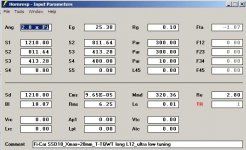 Fi_Car_SSD18_Infrasonic_long L12_Input.jpg37.7 KB · Views: 158
Fi_Car_SSD18_Infrasonic_long L12_Input.jpg37.7 KB · Views: 158 -
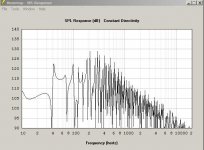 Fi_Car_SSD18_Infrasonic_long L12_SPL.jpg35.3 KB · Views: 154
Fi_Car_SSD18_Infrasonic_long L12_SPL.jpg35.3 KB · Views: 154 -
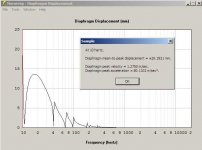 Fi_Car_SSD18_Infrasonic_long L12_displacement.jpg27.2 KB · Views: 154
Fi_Car_SSD18_Infrasonic_long L12_displacement.jpg27.2 KB · Views: 154 -
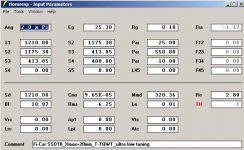 Fi_Car_SSD18_Infrasonic_short L12_Input.jpg37.4 KB · Views: 144
Fi_Car_SSD18_Infrasonic_short L12_Input.jpg37.4 KB · Views: 144 -
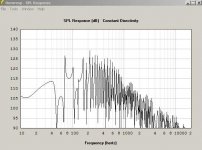 Fi_Car_SSD18_Infrasonic_short L12_SPL.jpg33.7 KB · Views: 41
Fi_Car_SSD18_Infrasonic_short L12_SPL.jpg33.7 KB · Views: 41 -
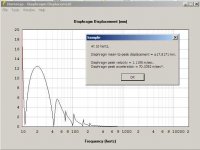 Fi_Car_SSD18_Infrasonic_short L12_displacement.jpg30.7 KB · Views: 46
Fi_Car_SSD18_Infrasonic_short L12_displacement.jpg30.7 KB · Views: 46
Blizzardbuffalo,
You have overlooked that the acceptable levels for hearing damage are measured using the dBA scale, which rolls off in response below 1000 Hz.
It takes 130 dB SPL to read 80 dBA at 20 Hz.
Upper frequencies, in particular those centered around 4000 Hz where hearing is most sensitive, cause damage at far lower levels than low frequencies.
If that were not the case, we would be deafened from closing car doors, which are on the order of 130 dB SPL at very low frequencies inside the cabin.
Art
It depends on who you ask, in Australia the guidelines for industrial relations related legal limits are in dB(A), however all the general government guidelines state 85dB. In the US the CDC uses dB instead of dB(A) with it's guidelines for preventing hearing loss, as does the US department of Labor. If they are using a weighting scale, they do not mention it.
As for car doors slamming, you may very well be deafened in that frequency range and not even know it. Permanant hearing damage doesn't nessisarily mean total deafness, it can mean reduced or no sensitivity in the affected frequency range.
However, in a non weighted scale a car door slamming is widely considered to be around 90dB (depending on the car) and should be fine unless you enjoy slamming car doors continuously for 8 hours a day. Interestingly enough, this study done on behalf of volvo shows that at 28Hz a door closing normally reached 42.88dB(A) to 43.14dB(A) and quickly closing a door reached 48.18db(A) to 49.07db(A). That study may actually be of interest to the OP as it has a focus on the quality of sound that comes from car door closing.
It depends on who you ask, in Australia the guidelines for industrial relations related legal limits are in dB(A), however all the general government guidelines state 85dB. In the US the CDC uses dB instead of dB(A) with it's guidelines for preventing hearing loss, as does the US department of Labor. If they are using a weighting scale, they do not mention it.
As for car doors slamming, you may very well be deafened in that frequency range and not even know it. Permanant hearing damage doesn't nessisarily mean total deafness, it can mean reduced or no sensitivity in the affected frequency range.
However, in a non weighted scale a car door slamming is widely considered to be around 90dB (depending on the car) and should be fine unless you enjoy slamming car doors continuously for 8 hours a day. Interestingly enough, this study done on behalf of volvo shows that at 28Hz a door closing normally reached 42.88dB(A) to 43.14dB(A) and quickly closing a door reached 48.18db(A) to 49.07db(A). That study may actually be of interest to the OP as it has a focus on the quality of sound that comes from car door closing.
Hi,
look at the second image on this website (not my website, googled). The image shows the so called auditory field or hearing area (Hörfläche in German), taken from the works of Profs. Fastl and Zwicker.
The limit of damage risk is plotted across the frequency spectrum in that diagram, and you can see that while it beings at below 90dB unweighted SPL at around 3kHz where the ear is most sensitive, it is already up to 130dB (!) at 30Hz. Unfortunately it is not plotted to frequencies lower than 30Hz, but assuming an asymptotic continuation or even a slight change in direction, it is highly unlikely to be lower than 120dB anywhere between 30Hz and the single digits.
I'm unsure of the precise methodology that has been used to obtain any of these various hearing safety guidelines, however most sources that make any attempt to differentiate between the frequencies of different stimuli agree that the damage threshold is higher for lower frequencies, but differ perhaps by how much.
Any safety guideline listing only a single value is IMO simply erring on the side of caution, listing the worst case value as to always be below this threshold, particularly for laymen attempting to follow this guideline.
I am neither a doctor nor a lawyer, however most of what I have read on this subject leads me to believe (and behave accordingly) that at sub-40Hz frequencies SPLs of up to 110dB are of no major concern to my hearing health. And the closer we get to DC, the less concern there is to be had, as the Eustachian Tube will simply equalize away any low frequency high SPL pressure fluctuations.
For sure, cones are lousy at sounds below 200 Hz and are just part of the anthropocentric issues - like the term "infrasound" itself. While I can't offer suggestions, making waves can't be hard.
Your real work starts when you try to get some control over the stimulus. Biggest challenge is physical: to make low sounds without triggering sympathetic sounds at audible frequencies*. A mic can tell you if audible frequencies are present.
Next, you need to scale whatever-it-is that makes the sound by doing psychophysical judgment/scaling. That will mean you know what represents equal loudness for your participants.
Then you can play tunes or whatever to judge the human responses. For example, you could compare tuneful tunes with discordant. Even if people can't "hear" the tune with their ears or even perceive with their sternums, they might be able to form judgments about which is "nicer" sounding.
But you can't get to that point unless you have decent control over your stimulus sounds.
*that might include harmonics generated within people's ears. I'm not sure how to address that artifact, if indeed you consider it an artifact.
Ben
Your real work starts when you try to get some control over the stimulus. Biggest challenge is physical: to make low sounds without triggering sympathetic sounds at audible frequencies*. A mic can tell you if audible frequencies are present.
Next, you need to scale whatever-it-is that makes the sound by doing psychophysical judgment/scaling. That will mean you know what represents equal loudness for your participants.
Then you can play tunes or whatever to judge the human responses. For example, you could compare tuneful tunes with discordant. Even if people can't "hear" the tune with their ears or even perceive with their sternums, they might be able to form judgments about which is "nicer" sounding.
But you can't get to that point unless you have decent control over your stimulus sounds.
*that might include harmonics generated within people's ears. I'm not sure how to address that artifact, if indeed you consider it an artifact.
Ben
Last edited:
Blizzardbuffalo,It depends on who you ask, in Australia the guidelines for industrial relations related legal limits are in dB(A), however all the general government guidelines state 85dB. In the US the CDC uses dB instead of dB(A) with it's guidelines for preventing hearing loss, as does the US department of Labor. If they are using a weighting scale, they do not mention it.
However, in a non weighted scale a car door slamming is widely considered to be around 90dB (depending on the car) and should be fine unless you enjoy slamming car doors continuously for 8 hours a day. Interestingly enough, this study done on behalf of volvo shows that at 28Hz a door closing normally reached 42.88dB(A) to 43.14dB(A) and quickly closing a door reached 48.18db(A) to 49.07db(A).
The references you posted do have footnotes tying them to NIOSH and OSHA, both use dBA, not dB SPL.
The "quickly closing a door reached 49.07db(A) at 28Hz " would read about 40 dB higher (89.07) read without weighting.
- Status
- This old topic is closed. If you want to reopen this topic, contact a moderator using the "Report Post" button.
- Home
- Loudspeakers
- Subwoofers
- Infrasonic Speaker - Need advice for undergrad thesis project
